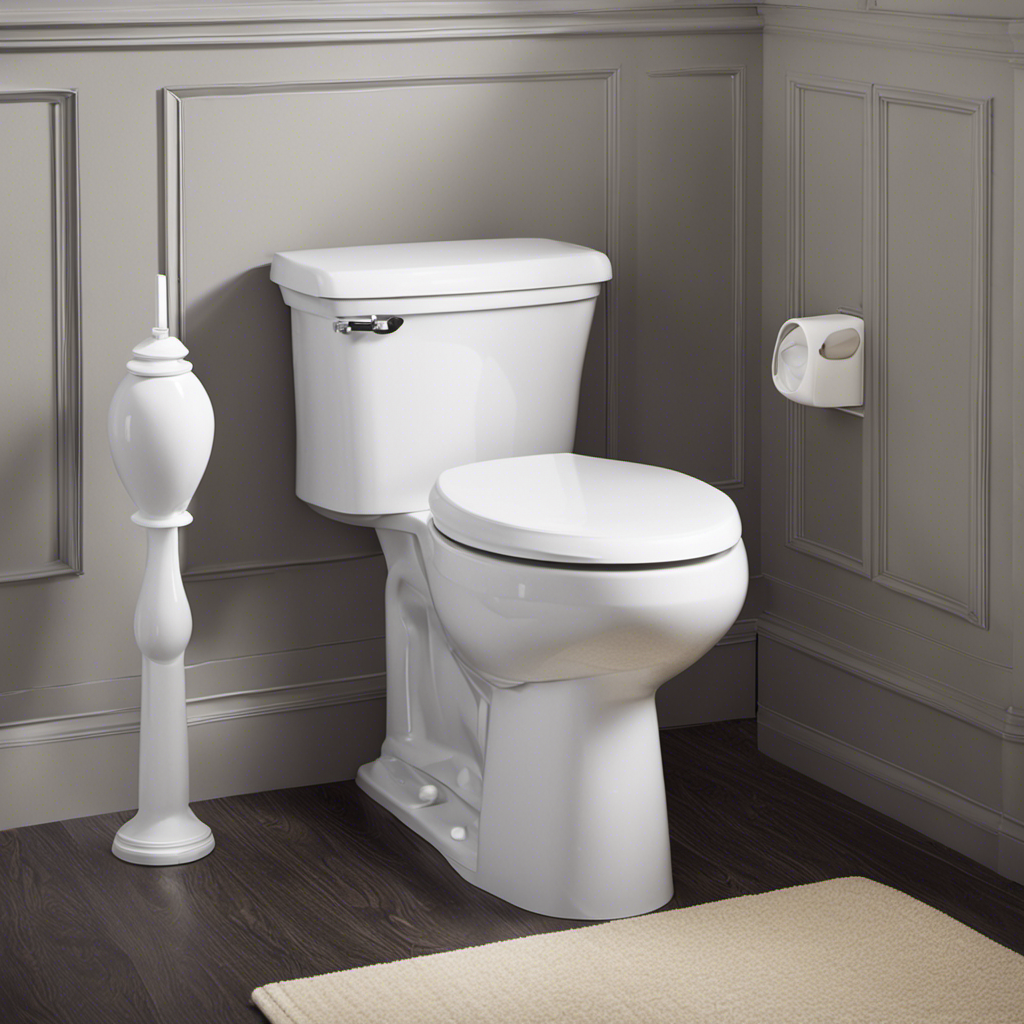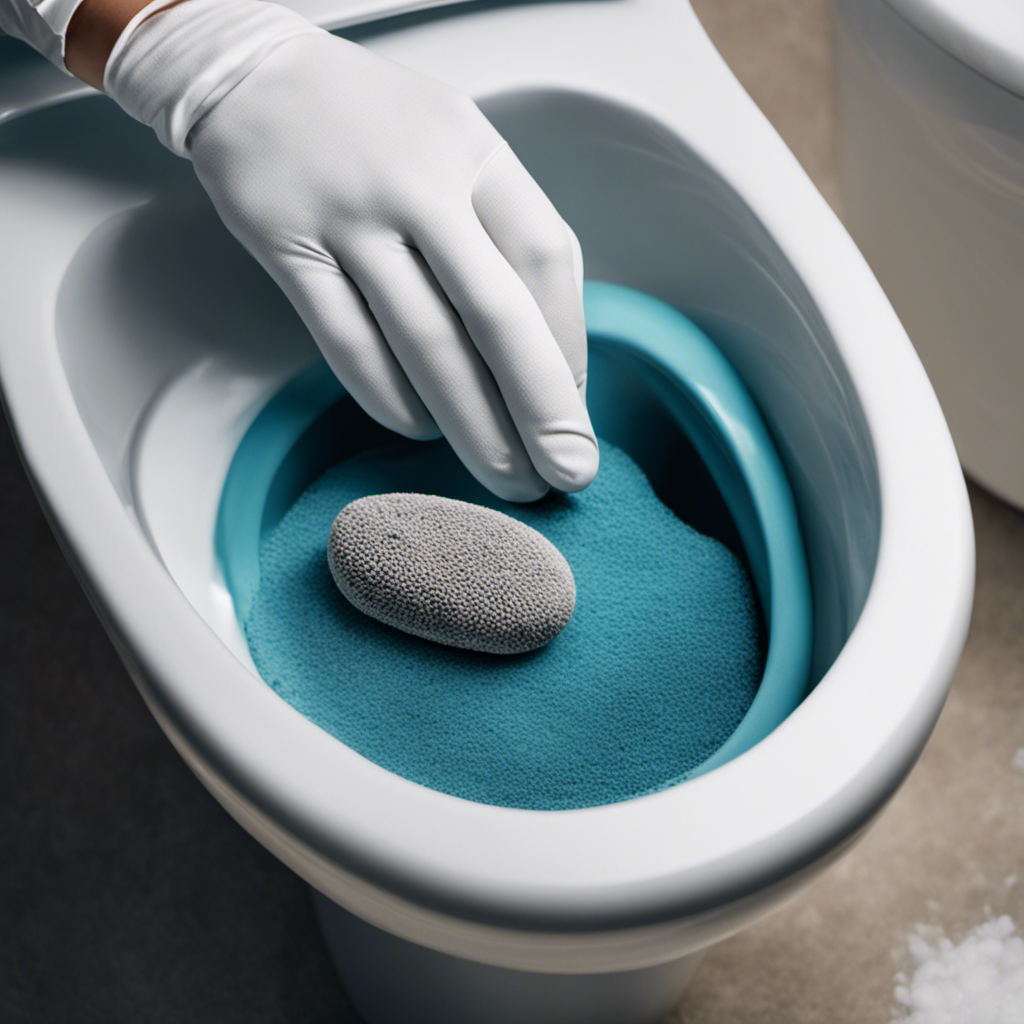Are you tired of dealing with frozen pipes and a non-functioning toilet during the winter months? Well, fear not! In this article, we will show you how to winterize your toilet and ensure that it continues to work smoothly even in the coldest of temperatures.
From assessing the need for winterization to gathering the necessary tools and materials, we’ve got you covered.
So grab your toolkit and let’s get started on protecting your toilet from the winter chill!
Key Takeaways
- Assess the need for winterization by checking for leaks or cracks and considering potential water damage and costly repairs.
- Gather the necessary tools and materials such as insulating foam kit, pipe insulation sleeves, and toilet tank insulator kit.
- Drain the water supply by locating the main shut-off valve, opening faucets and drains, and disconnecting outdoor hoses or sprinkler systems.
- Ensure proper water drainage by shutting off the water supply, flushing the toilet, and removing any remaining water using a sponge or towel.
Assessing the Need for Winterization
Before you can start winterizing your toilet, you need to assess whether or not it requires winterization. This step is crucial because not all toilets need to be winterized. Assessing the need for winterization can save you money on plumbing repairs in the long run.
The first thing you should look for is any signs of leaks or cracks in the toilet tank or bowl. These can lead to water damage and costly repairs if not addressed.
Additionally, check if your toilet is located in an area of your home that is prone to freezing temperatures. If it is, then winterizing your toilet is essential to prevent frozen pipes and potential bursts.
Gathering the Necessary Tools and Materials
First, make sure you have all the tools and materials you’ll need for the job. Here are three essential items to gather for toilet insulation during the winterization process:
-
Insulating foam kit: This kit contains foam insulation that will help seal any gaps around the toilet to prevent cold air from entering and warm air from escaping. It’s easy to use and provides excellent insulation.
-
Pipe insulation sleeves: These sleeves are designed to wrap around the exposed pipes connected to the toilet. They provide an extra layer of insulation, preventing the pipes from freezing and potentially bursting during cold weather.
-
Toilet tank insulator kit: This kit includes an insulating material that you can place inside the toilet tank to prevent water from freezing. It helps maintain the temperature and prevents any damage to the tank or the flushing mechanism.
Draining the Water Supply
To properly drain the water supply in preparation for winter, it’s important to follow a few key steps.
First, locate the main shut-off valve for your water supply and turn it off.
Next, open all faucets and drains in your home to allow the water to drain out completely.
Lastly, don’t forget to disconnect and drain any outdoor hoses or sprinkler systems to prevent frozen pipes and potential damage.
Proper Water Drainage
You’ll need to drain all the water from the toilet tank and bowl. Proper water maintenance is essential for winter plumbing to prevent frozen pipes and costly repairs. Follow these steps to ensure proper water drainage:
-
Shut off the water supply: Locate the shut-off valve behind the toilet and turn it clockwise to stop the flow of water.
-
Flush the toilet: Hold down the handle until the tank is empty and the bowl is clear of water. This will remove most of the water from the system.
-
Remove any remaining water: Use a sponge or a towel to soak up any residual water in the tank and bowl. Wring out the excess water into a bucket or sink.
Preventing Frozen Pipes
Make sure to insulate your pipes properly to prevent them from freezing during the winter months. Freezing pipes can cause significant damage to your plumbing system and result in costly repairs.
Luckily, there are several winterization techniques you can employ to protect your pipes. Firstly, identify any exposed pipes in unheated areas such as the basement or crawl spaces. Wrap them with insulation sleeves or use heat tape to provide an extra layer of protection.
Additionally, keep the temperature inside your home consistent, even when you’re away. Set your thermostat to a minimum of 55 degrees Fahrenheit to prevent freezing.
By taking these simple steps, you can safeguard your pipes from freezing and prevent potential damage.
Now, let’s move on to insulating the toilet tank and bowl.
Insulating the Toilet Tank and Bowl
When it comes to insulating your toilet tank and bowl, there are several benefits to consider.
Insulation helps to prevent condensation, keeps the water warmer for longer, and reduces the risk of freezing during colder months.
To get started, you will need a few materials such as foam insulation, duct tape, and a utility knife.
Follow these step-by-step instructions to effectively insulate your toilet and enjoy the many benefits it brings.
Benefits of Insulation
To keep your toilet from freezing during the winter, insulating it has several benefits. Here are three reasons why insulating your toilet can be advantageous:
-
Energy Savings: Insulating your toilet can help conserve energy by reducing heat loss. A properly insulated toilet tank and bowl can prevent heat from escaping, allowing your toilet water to stay warmer for longer periods. This means you won’t need to use as much hot water to flush, leading to energy savings and lower utility bills.
-
Prevention of Freezing: Insulation acts as a barrier against freezing temperatures. By insulating your toilet, you create an extra layer of protection that helps prevent the water inside the tank and bowl from freezing. This is especially important in colder climates, where freezing pipes can lead to costly repairs.
-
Extended Lifespan: By insulating your toilet, you can prolong its lifespan. The insulation helps to regulate the temperature, preventing extreme fluctuations that can cause stress on the toilet components. This added protection can reduce the risk of cracks or leaks, extending the lifespan of your toilet and saving you money in the long run.
Insulating your toilet not only provides energy savings but also helps prevent freezing and extends the lifespan of your toilet. It’s a practical and cost-effective way to ensure your toilet functions well during the winter months.
Materials Needed
You’ll need a few materials to properly insulate your toilet and ensure it stays warm during the cold months.
Insulating your toilet is an effective method to prevent freezing and potential damage to the pipes.
To get started, you’ll need a toilet insulating kit, which typically includes a foam pad and an adhesive strip. The foam pad is placed between the toilet tank and the wall, providing an extra layer of insulation.
Additionally, you’ll need a pipe insulation wrap to cover the exposed pipes. This helps to retain heat and prevent freezing.
Lastly, don’t forget to have a tube of silicone sealant handy. This will be used to seal any gaps or cracks around the toilet base, further enhancing insulation and preventing cold air infiltration.
With these materials, you can easily and effectively insulate your toilet, ensuring its proper maintenance during the winter months.
Step-By-Step Instructions
First, ensure you have all the necessary materials for insulating your toilet. To properly prepare your plumbing for the winter and ensure your toilet is protected from freezing temperatures, follow these step-by-step instructions:
-
Insulate the tank: Wrap the tank with a toilet tank insulator, which can be found at your local hardware store. This insulation will help retain heat and prevent the water inside from freezing.
-
Insulate the pipes: Use foam pipe insulation to wrap the exposed pipes connected to your toilet. This will help prevent them from freezing and bursting.
-
Seal any drafts: Check for any drafts around the toilet and seal them with caulk or weatherstripping. This will help keep the cold air out and maintain a warmer temperature around the toilet.
Sealing and Protecting External Pipes and Valves
Don’t forget to insulate the external pipes and valves to protect them from freezing temperatures. Sealing techniques and weatherproofing methods are essential to ensure that your toilet remains functional throughout the winter months. By properly sealing and protecting the external pipes and valves, you can prevent any damage caused by freezing temperatures. Here are some effective weatherproofing techniques you can use:
| Sealing Technique | Weatherproofing Method |
|---|---|
| Caulking | Apply silicone caulk around the pipes and valves to create a waterproof seal. |
| Insulation | Wrap the pipes and valves with foam insulation sleeves to provide an extra layer of protection. |
| Heat Tape | Install heat tape along the pipes and valves to keep them warm and prevent freezing. |
| Pipe Insulation | Use pipe insulation to cover any exposed pipes and valves to prevent heat loss and freezing. |
Maintaining the Winterized Toilet
Now that you’ve sealed and protected your external pipes and valves, it’s time to focus on maintaining the winterized toilet. This will ensure that your toilet stays in good condition throughout the cold season. Here are three important steps to follow:
-
Check for leaks: Regularly inspect the toilet for any signs of leaks or drips. A small leak can quickly turn into a bigger problem, leading to water damage and increased utility bills. Look for water pooling around the base of the toilet or any wet spots on the floor. If you notice any leaks, promptly fix them to prevent further damage.
-
Maintain insulation: Make sure the insulation around your toilet tank and bowl is intact. Insulation helps prevent heat loss and keeps the water in the tank from freezing. Check for any gaps or cracks and use insulation materials, such as foam pipe insulation or duct tape, to seal them.
-
Keep the toilet warm: To prevent freezing, keep the temperature in your bathroom above freezing. You can do this by leaving the heating on or using a space heater. Additionally, consider leaving the cabinet doors under the sink open to allow warm air to circulate around the toilet.
Conclusion
So there you have it, you now know how to properly winterize your toilet. By following these simple steps, you can ensure that your toilet remains in good working condition throughout the winter months.
Did you know that according to a study conducted by the Environmental Protection Agency, the average household can save up to 10 gallons of water per day by using a winterized toilet? That’s a significant amount of water conservation, and it’s just one of the many benefits of winterizing your toilet.
So don’t wait, take the necessary steps to protect your toilet today and enjoy a worry-free winter season.










